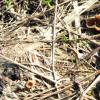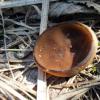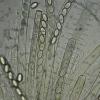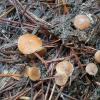
20-12-2025 23:08
Patrice TANCHAUDBonsoir, récolte sur sol sablonneux dans l'arri�

21-12-2025 09:32
Hello.A tiny ascomycete found embedded in wood in

20-12-2025 15:47
Mirek GrycHi.These grew on pine wood that was heavily covere

18-12-2025 21:17
Pol DebaenstThe identification took me to Byssonectria deformi

15-12-2025 07:09
 Danny Newman
Danny Newman
indet. Rutstroemiaceae sp. on unk. fallen leavesMc

19-12-2025 10:10
Patrice TANCHAUDBonjour, récolte réalisée en milieu dunaire, a

18-12-2025 17:23
 Bruno Coué
Bruno Coué
Bonjour,je serais heureux d'avoir votre avis sur c
the snow has almoust melted away here. Near the snow border appeared Pezizas on places with plant debris. I became curious after finding it severeal times. Just couldn't come to determination with my sources.
These have smooth spores about 18-20x 9-11.
The asci are about 300x10+ and paraphyses septate and have swollen cells besides of narrower ones.
P. repanda seems to have smaller spores according to my sources.
Marja

Try to look closer to mature spore wall (of spores discharged from living asci without applied pressure). Also apply any form of Cotton blue mount. Regardless of CB staining procedure variant you should be able to see at least tiny punctate to microverrucose cyanophilous ornamentation.
In such case, together with the rest of ascospore characters (dimensions, no guttules, shape) and the moniliform paraphyses, macromorphology as well as characteristic fenology (fructification at snowmelt time & place) this should be Peziza nivalis (Heim et Remy) M.M.Moser (=P. ninguis Donadini et Trimbach).
Cheers,
Neven
Près de la neige fondante, croissent différentes espèce du genre Peziza : P. nivalis, P. ninguis et P. nivis. Il est possible que votre récolte corresponde à de Peziza ninguis Donadini & Trimbach dont les paraphyses deviennent ampullacées, c'est alors l'ancienne P. ninguis var. fortoulii Donadini, devenue synonyme de P. ninguis.
La propriété qu'ont certaines espèces de Pezizales, mais non seulement de Peziza, à avoir les paraphyses et parfois les cellules de la chair à ce déformer, à renflées pour les paraphyses, a été décrit par Donadini sous le non de « fortulisme ». Il distingue deux types:
a) Le fortoulisme génotypique, caractérisé par P. varia Hedwig : Fr. et dans une moindre mesure par P. vesiculosa Bulliard :Fr., aux paraphyses peu moniliformes dans la jeunesse, mais le devenant toutes vers la maturité, en particulier à la base.
b) Le fortoulisme phénotypique de P. ninguis Donadini & Trimbach et de sa variété fortoulii (Donadini & Neville) Donadini est, pour l'essentiel, le résultat de conditions écologiques particulières (humidité très élevée du substrat et variation de la température).
Vous trouvez de nombreux travaux de Donadini, dont son travail sur les espèces nivales, sur le site ascomycete.org, que je ne peux que recommander aux ascomycophiles,
Enfin, les travaux de génétique de Hansen et al. (2002) in Mycol. Res. 106 (8) : 879-902, ont conduit à placer en synonymie P. cerea et P. micropus avec P. varia. Le nom de P. repanda est rejeté. Je pense aussi que les ascospores sont trop grande pour P. varia.
Je demande à Neven et à Nicolas, qui semble être en accord avec Neven, comment se fait-il que P. ninguis, aux ascospores mesurant 18,5-20,5 x 10-11,5 ?m ait été synonymisé avec P. nivalis aux ascospores mesurant 26-30 x 13-16 ?m ? Y a-t-il des confusions avec ces espèces ?
Amicalement
René

pour répondre à ta dernière question, tout dépend si tu interpètes P. nivalis au sens originel de Heim & Rémy (sub nom. Galactinia nivalis) en 1932, ou selon leur amendement du nom (sub Aleuria nivalis) en 1947. L'ami Branislav Peric a retracé cet imbroglio dans l'article suivant:
Peric B. 2010 [2009]. Peziza nivalis, deux récoltes nouvelles pour le Monténégro. Mycol. Monten., XII: 19-32.

According to Pfister (1992): A collection of Peziza nivalis from California with comments on the nomenclature of the snow bank pezizas; Mycotaxon 43: 171-175; true P. nivalis is the species with smaller spores (viz. 16-21 × 11-12 micr.; according to my data *17-22 × 10-12 micr.; according to Heim et Remy: 14-17 × 9-11 micr., probably immature!) so he placed P. ninguis under the synonymy (spores according Donadini: 18,5-20,5 × 10-11,5 micr.).
Pfister (1992) also designated P. flos-nivium Donadini as the superfluous name of P. nivalis as Donadini (1977 and 1979) clearly state the neccesity of nomen novum for the nival species with larger and smooth spores (26-30 × 13-16 micr.) but he bounded this name as a nomen novum for validly published P. nivalis (a different small-spored species). For that reason he established P. heimii Pfister as a name for bigger spored species (spores acc. Pfister 27-33 × 15-16 micr.)
Anyway, I almost sent my manuscript for publication also concerning the nival Peziza species at the begining of nineties. but I cancelled it at the last minute as I became subsequently aware of another nival species P. nivis (Nicolas posted as the reply to Marja's and my posts). So I decided to wait with this paper untill I manage to find P. nivis and treat it in living state and compare with the other two. Unfortunately, I never found P. nivis so far so my material remained unpublished.
I concur with your and Donadini's views about fortoulisme and did monitored such paraphysis cell swellings over vast number of P. varia and P. vesiculosa collections, but also in some other genera (such as Ascobolus, Thecotheus etc.).
Cheers,
Neven
Merci de vos réponses. Je vais consulter la littérature indiquée. Encore une fois, en mycologie, les échanges sont indispensables.
Amitiés à tous deux
René

9-V-2003 - Grande Sassière, Tignes, France - alt. 2400 m - 22-24 x 10.3-12 µm
8-VI-2010 - Col des Champs, Colmars-les-Alpes, France - alt. 2050 m - 24-25 (26) x 14-16 µm
just came home from our country place and was ashtonished of so many replys.
The snow has melted and I can't get fresh ones any more. Just some dried ones are left.
Suprisingly I did not find any information of P, nivalis Finnish collections. Maybe they are determined as P. repanda. Anyway, in the future I'll keep these spring Peziza-species on eye while looking for nivicole myxos.
Once again: thank you all very, very much: Marja




